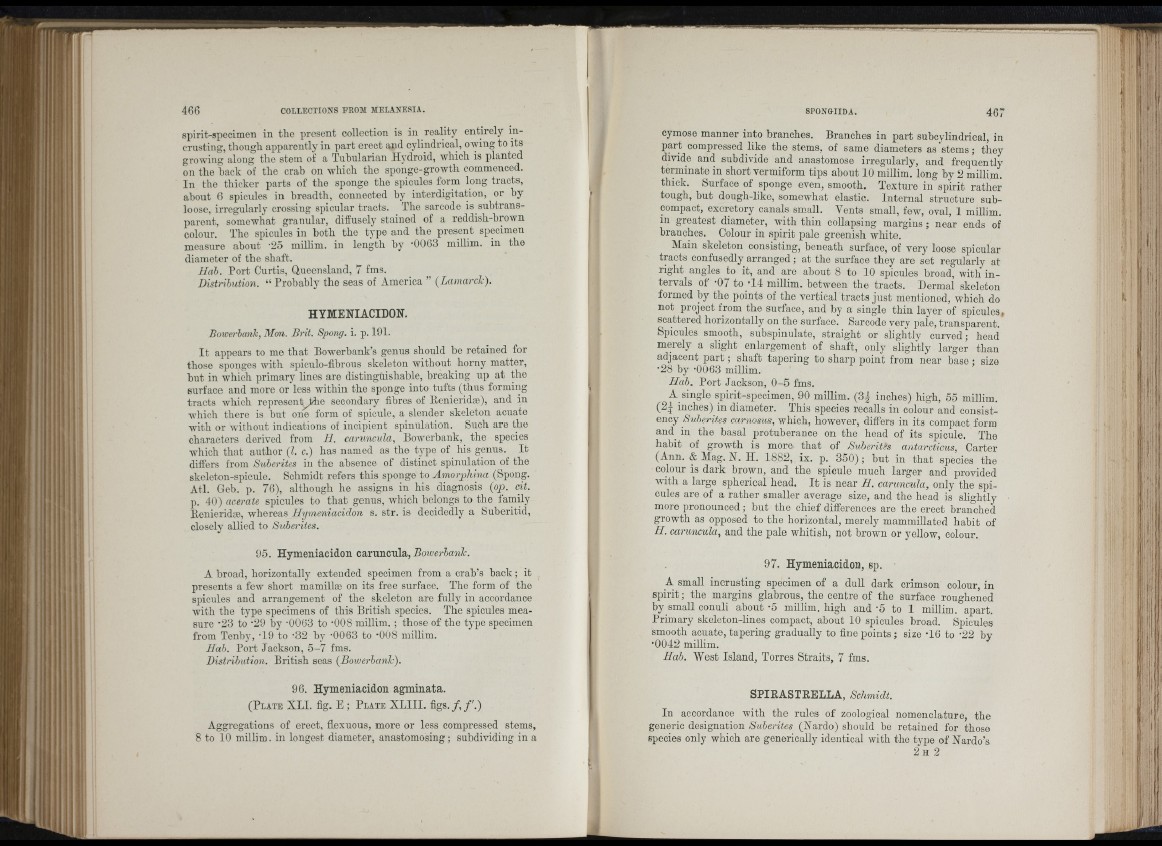
i j :
466 COLLECTIONS FEOM M E LA N E S IA .
spirit-specimen in the present collection is in reality entirely in-
crusting, though apparently in part erect aud cylindrical, owing to its
growing along the stem of a Tuhularian Hydroid, which is planted
ou the back of the crab on which the sponge-growth commenced.
In the thicker parts of the sponge the spicules form loug tracts,
about 6 spicules in breadth, connected by interdigitation, or by
loose, irregularly crossing spicular tracts. The sarcode is subtransparent,
somewhat granular, diffusely stained of a reddish-brown
colour. The spicules iu both the type and the present specimen
measure about '25 millim. in length by ‘OOdS millim. in the
diameter of the shaft.
Hah. Port Curtis, Queensland, 7 fms.
Distrihution. “ Probably the seas of America ” {Lamardc).
HYMENIACIDON.
Boiverhank, Alon. Brit. Spong. i. p. 191.
I t appears to me th a t Bowerhank’s genus should be retained for
those sponges with spiculo-fibrous skeleton without horny matter,
but in which primary lines are distinguishable, breaking up ^ a t the
surface and more or less within the sponge into tufts (thus forming
tracts which representf f h e secondary fibres of llenieridse), and in
which there is but one form of spicule, a slender skeleton acuate
with or without indications of incipient spinulation. Such are the
characters derived from H. carúncula, Bowerbank, the species
which th at author (I. c.) has named as the type of his genus. I t
differs from Suberites iu the absence of distinct spinulation of the
skeleton-spicule. Schmidt refers this sponge to Amorqyhina (Spong.
Atl. Geb. p. 76), although he assigns iu his diagnosis (op. cit.
p. 40) acerate spicules to th at genus, which belongs to the family
Kenieridse, whereas Hymeniacidon s. str. is decidedly a Suheritid,
closely allied to Suberites.
95. Hymeniacidon carnncula, Boiverbank.
A broad, horizontally extended specimen from a crab’s h a ck ; it
presents a few short mamillm on its free surface. The form of tho
spicules and arrangement of the skeleton are fully in accordance
with the type specimens of this British species. The spicules measure
‘23 to '29 by -0063 to "008 millim. ; those of the type specimen
from Tenby, '19 to ‘32 by -0063 to -OOS millim.
Hab. Port Jackson, 5 -7 fms.
Distribution. British seas (Bowerbank).
96. Hymeniacidon agminata.
( P l a t e XLI. fig. E ; P l a t e X L III. figs. / , / ' . )
Aggregations of erect, flexuous, more or less compressed stems,
8 to 10 millim. in longest diameter, anastomosing; subdividing in a
S PO N G IID A . 461
cymose manner into branches. Branches in part subcylindrical, in
part compressed like the stems, of same diameters as stems; they
divide and subdivide and anastomose irregularly, and frequently
terminate in short vermiform tips about 10 millim. long hy 2 millim.
thick. Surface of sponge even, smooth. Texture in spirit rather
tough, but dough-like, somewhat elastic. Internal structure subcompact,
excretory canals sm.all. Veuts small, few, oval, 1 millim.
in greatest diameter, with thin collapsing margius ; near ends of
branches. Colour in spirit pale greenish white.
Main skeleton consisting, beneath surface, of very loose spicular
tracts confusedly arranged; at the surface they are set regularly at
right angles to it, and are about 8 to 10 spicules broad, with in tervals
of '07 to ‘14 millim. between the tracts. Dermal skeleton
formed by the points of the vertical tracts ju s t mentioned, which do
not project from the surface, and by a single thin layer of spicules,,
scattered horizontally on the surface. Sarcode very pale, transparent.
Spicules smooth, subspinulate, straight or slightly curved; head
merely a slight enlargement of shaft, only slightly larger than
adjacent p a r t ; shaft tajiering to sharp point from near base : size
•28 by '0063 millim.
Hah. Port Jackson, 0 -5 fms.
A single spirit-specimen, 90 millim. (3¿ inches) high, 55 millim.
(24 inches) in diameter. This species recalls iu colour and consistency
Suberites carnosus, which, however, differs in its compact form
and in the basal protuberance ou the head of its spicule. The
habit of growth is more th at of Suberites antarcticus. Carter
(Ann. &Mag. X. H. 1882, ix. p. 35 0 ); but in th at species the
colour is dark brown, and the spicule much larger and provided
Avith a large spherical head. I t is near H. carúncula, only the spicules
are of a rather smaller average size, and the head is slightly
more pronounced; but the chief differences are the erect branched
growth as opposed to the horizontal, merely mammillated habit of
H. carúncula, aud the pale whitish, not brown or yellow, colour.
97. Hymeniacidon, sp.
A small incrusting specimen of a dull dark crimson colour, in
sp irit; the margins glabrous, the centre of the surface roughened
by small conuli about -5 millim. high aud -5 to 1 millim. apart.
Primary skeleton-lines compact, about 10 spicules broad. Spicules
smooth acuate, tapering gradually to fine p o in ts; size -16 to -22 bv
•0042 millim.
Hab. West Island, Torres Straits, 7 fms.
SPIRASTRELLA, Schmidt.
In accordance with the rules of zoological nomenclature, the
generic designation Suberites (Xardo) should be retained for those
species only which are generically identical with the tj-pe of Xardo’s
2 u 2
i'i
J 'Í?
1t
i ii
l-T